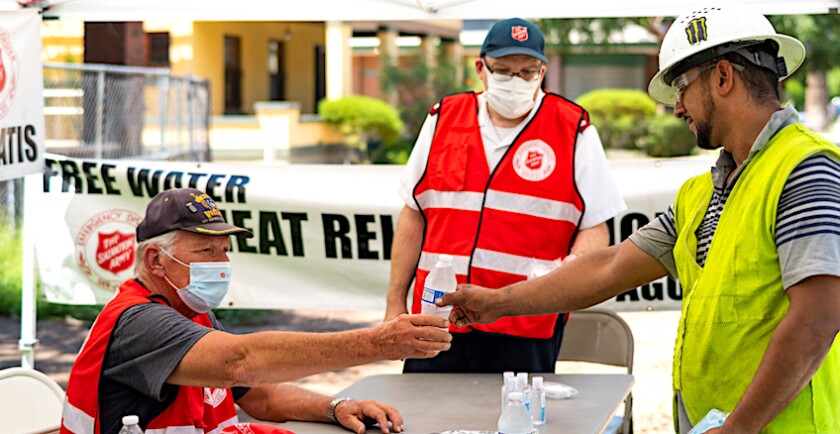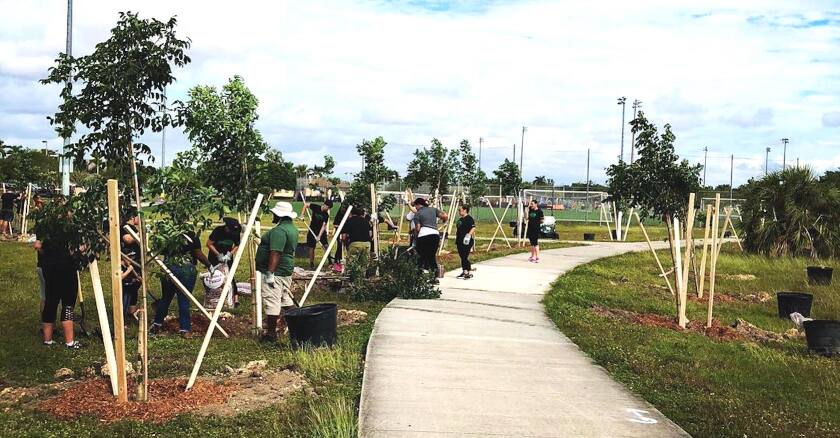“Why are flooding and mold more frequent?”
“Why is it getting so hot that our kids can’t go outside and play?”
The last eight years have been among the eight hottest on record globally, with 2023 on track to be the hottest year ever recorded. This summer has seen days with more than 100 million Americans living under extreme heat advisories. And 2023 has also been a year of devastating floods across the nation, from California to Vermont.
As heat waves set records and floods reach higher marks, community members living in neighborhoods built to overheat and vulnerable to floodwaters want solutions. And they deserve them.
Many neighborhoods, including most that are home to people of color, are not designed for today’s climate. In fact, past city surfacing decisions have made neighborhoods nationwide hotter, more prone to flooding and less healthy — and climate change is making things worse. Cities’ responses to these threats have been limited and ineffective, sometimes even exacerbating conditions.
As the media reports on torrential rains and unhealthy heat, it also needs to cover why cities are getting hotter and why some neighborhoods suffer more than others.
Low-income neighborhoods/areas/districts and communities of color are often 10 degrees hotter than wealthier, tree-lined neighborhoods, and that results directly from past city decisions to cover neighborhoods in black, heat-absorbing asphalt with few trees or permeable surfaces to manage rainfall. Summer heat and flooding in lower-income neighborhoods reflect past racist redlining practices. Because climate change compounds the environmental justice burden, cities need to make very different surface decisions.
A bipartisan coalition of mayors from Atlanta, Baltimore, Boston, Dallas, New Orleans and Columbia, S.C., has just embraced the opportunity to deliver citywide cooling, mitigate flooding and lower energy bills while addressing climate concerns. These mayors signed up with the Smart Surfaces Coalition and partners like the National League of Cities and the American Public Health Association to think differently — to imagine how they can cool their neighborhoods by 5 degrees or more using “smart surfaces” to make their cities cooler as the world gets hotter.
Cities can cool and reduce flooding through citywide adoption of reflective, porous and green surfaces, along with trees and solar photovoltaic panels on roofs and parking lots. Together these can double how much sunlight is reflected back into space, cooling the city and literally cooling the planet. This integrated approach can cut flooding and resulting mold by more than half while making neighborhoods greener, healthier and more shaded and restoring the outdoors for people to enjoy year-round. When people can be outdoors, they play, walk and socialize more. Crime drops. Exercise and mental well-being increase and loneliness eases.
The Smart Surfaces Coalition, a nongovernmental organization with 40 partners representing health, business, justice and more, has already worked with Baltimore to quantify and start implementing surfaces to cool the city. Among the strongest advocates were the mom-and-pop restaurants, motels and tourism services scared by declining summer tourism due to rising summer heat. As Baltimore City Councilman Mark Conway observes, “By adopting smart surfaces, we are protecting our city’s very future.”
Smart surfaces aren’t just a nice thing to do. They are urgent. In last summer’s record-breaking heat, 62,000 people died in Europe, and heat deaths are increasingly rapidly in the U.S. If we don’t act soon, cooling and hydration centers won’t be enough to save our neighbors and loved ones.
Surviving climate change isn’t a red or blue issue. It is a matter of common sense and livability. The Smart Surfaces Coalition has the resources to support five more cities to transform their urban quality of life. In the coming decade, most mayors will greenlight roads and building projects. Deciding whether to require smart surfaces is deciding whether to make life better or worse for residents.
Greg Kats serves as CEO ofthe Smart Surfaces Coalition, comprising 40 organizations committed to transforming urban surfaces globally, and is the author of “Greening our Built World: Costs, Benefits and Strategies.”
Governing’s opinion columns reflect the views of their authors and not necessarily those of Governing’s editors or management.
Related Content













